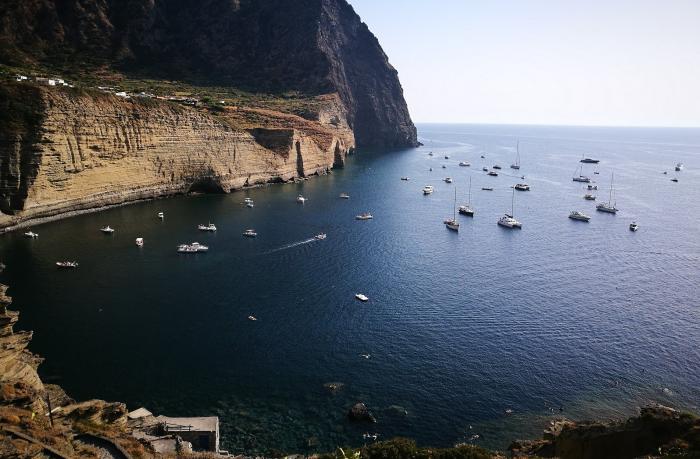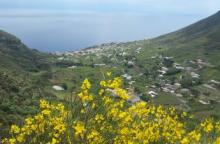
Island facts
The greenest of the Aeolian islands.
A volcanic island in the Mediterranean Sea with an abundance of olive trees and bushes of capers, Salina is part of the Aeolian islands North of Sicily. With its three cities Santa Marina, Malfa and Leni - home to around 2,500 inhabitants spread across 26km² - Salina is the second-largest island in the archipelago. Its pristine natural landscapes are what earned the archipelago the title of UNESCO World Heritage Site and made Italian director Massimo Troisi choose Salina as the set for his movie “Il Postino” (The Postman) - the inhabitants of the island will gladly point visitors to the most beautiful spots on the island. Salina’s main economic sectors are tourism, small organic farms and sustainable fishing.
Pollution in paradise?
But behind Salina’s paradisiac setting lies a significant problem. With an annual consumption of 1,800 tons of diesel oil and liquefied petroleum gas - representing more than 70% of the island’s energy consumption - Salina’s carbon emissions add up to almost 6,000 tons of CO2 per year. Most of the houses on Salina were built before 1960, and while their style forms part of the island’s charm, the energy performance of these houses is extremely poor. This leads to high electricity bills for the island’s inhabitants, as part of the energy needs to be imported from the mainland.
Public transport on the island is managed by a company owned by the three municipalities. It is covered by diesel-fuelled minibuses, which emit almost 135 tons of CO2 per year. The fuel for the cars on the islands, as well as drinking water, is brought to Salina by boat, which is also the main means of transport to and from the island.
Making Salina green again
Labelled by everyone “the greenest of the Aeolian islands”, Salina decided to give honour to its name and start its clean energy transition. It started with the signing of the Pact of Islands in 2013, followed by the establishment of Sustainable Energy Action Plans with clear targets for 2020 in all three municipalities. Since then, the island has taken initiatives to promote eco-tourism and reduce pollution and environmental degradation and is planning to implement energy-efficiency and energy-saving measures, particularly in public lighting systems and the heating and cooling of public buildings. The municipalities further aim to produce energy locally, capitalising on the island’s abundant renewable energy resources of electricity and heat, and to switch their public transport to electric minibuses powered by solar PV. The charging stations would be available for electric vehicles on the island as well. These initial plans and activities have been well received by residents, local tour operators and visitors.
Involving all actors of the local community - including citizens, companies, trade associations and tour operators - is a challenge Salina is working to overcome as it advances its energy transition. The municipalities driving the transition are aware of the shift needed in people’s mindsets to choose clean energy options, such as opting for an electric vehicle for a new car rather than one that runs on fossil fuel and plan targeted education and communications activities to bring the local community on board.
The island will further need to find solutions to finance the clean energy transition. A new law in Italy foresees an economic contribution by the government over the next 20 years for every kWh of electricity produced with solar PV. Current financial support is further provided through tax incentives for building renovation (covering about 50% of the costs over ten years) and for refurbishments to improve energy efficiency and seismic resilience in buildings (covering 65% of the costs over ten years), provided by ENEA.
Further national legislation in support of renewable energy is expected in the coming years following the recent finalisation of the European clean energy package. Salina’s transition efforts are supported by the Regional Department of Energy, which will contribute to the transition together with the three municipalities and ENEA.
The Clean Energy for EU Islands Secretariat will support Salina in its efforts to create a unified vision shaped by the island community over the coming months and to fulfil its objective to extend the clean energy transition to other Sicilian islands.
Project-specific support provided by the EU Islands Secretariat
Salina requested an estimation of the available wind and wave potential at the northwest offshore area of Salina, including technology recommendations. View the study here
Under the 30 for 2030 call the following activities are planned:
Repowering and Hybridisation of the PV Plant in Monte Sant’Angelo
This involves an analysis of the available solar and wind resources and the development of a multi-year data model. The current status of the PV plant and the legal framework for repowering are evaluated. Alternatives for delivering the produced electricity, such as power injection into the local grid or supplying power to the desalination plant, are examined with a techno-economic optimization of a hybrid solar, wind, and battery plant. A long-term yield assessment and cost estimation are conducted. A feasibility study is performed for the repowering and hybridisation of the PV plant with wind production and storage.
Technical Advice for the Repowering and Hybridisation of the PV Plant in Monte Sant’Angelo
This involves providing technical advice during various project phases including authorisation, connection, and tendering/procurement.
Pre-feasibility Study for a Biomass Plant
A pre-feasibility study and analysis of alternatives for a biomass energy plant in Lipari, supplied with the organic fraction of municipal solid waste (OFMSW) from the Aeolian Islands. The study includes preliminary sizing, cost estimation of the plant, and assessment of the costs and emissions associated with transport.
Assessment of the Sustainability of Biodiesel Power Generation and Transport
Development of a tool (calculation sheet) to support the sustainability assessment of biodiesel power generation in high-RES insular power systems and transport. This includes an estimation of the emissions associated with biodiesel power generation in Lipari and Salina.
Please note that the island of Salina has jointly applied for the 30 for 2030 call with Arcipelago di Lipari | Clean energy for EU islands (europa.eu).


